Business Environment and Organisational Functions
VerifiedAdded on 2020/07/22
|13
|4065
|210
AI Summary
The provided assignment details a comprehensive analysis of business environments and organisational functions. It includes various studies and research papers that examine the impact of business environment on socio-economic performance of informal microenterprises, entrepreneurial perception of SME business environment quality, and strategic fit between innovation strategies and business environment in delivering business performance. The summary also highlights the importance of understanding the relationship between different organisational functions and the interrelation of strengths and weaknesses with external macro organisation factors.
Contribute Materials
Your contribution can guide someone’s learning journey. Share your
documents today.
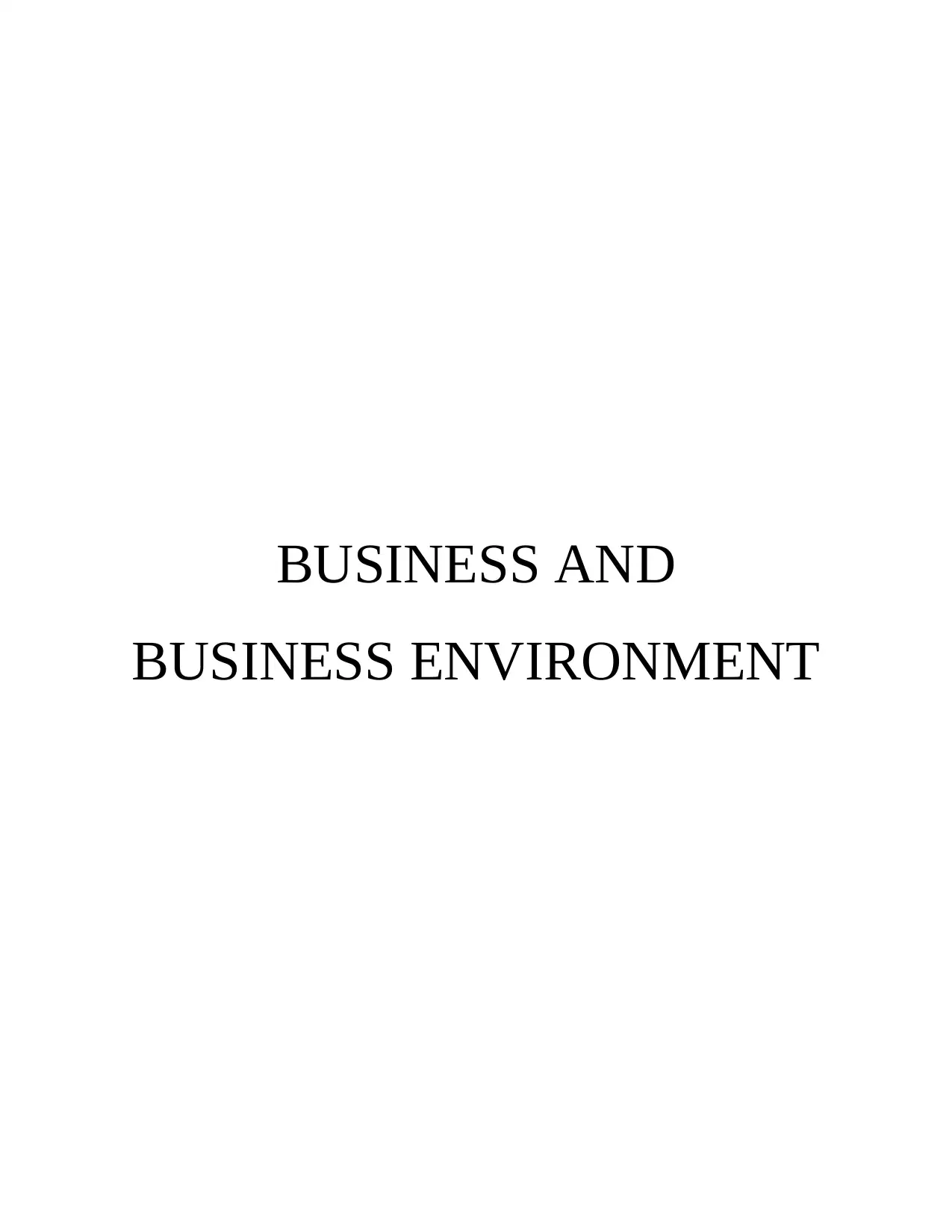
BUSINESS AND
BUSINESS ENVIRONMENT
BUSINESS ENVIRONMENT
Secure Best Marks with AI Grader
Need help grading? Try our AI Grader for instant feedback on your assignments.
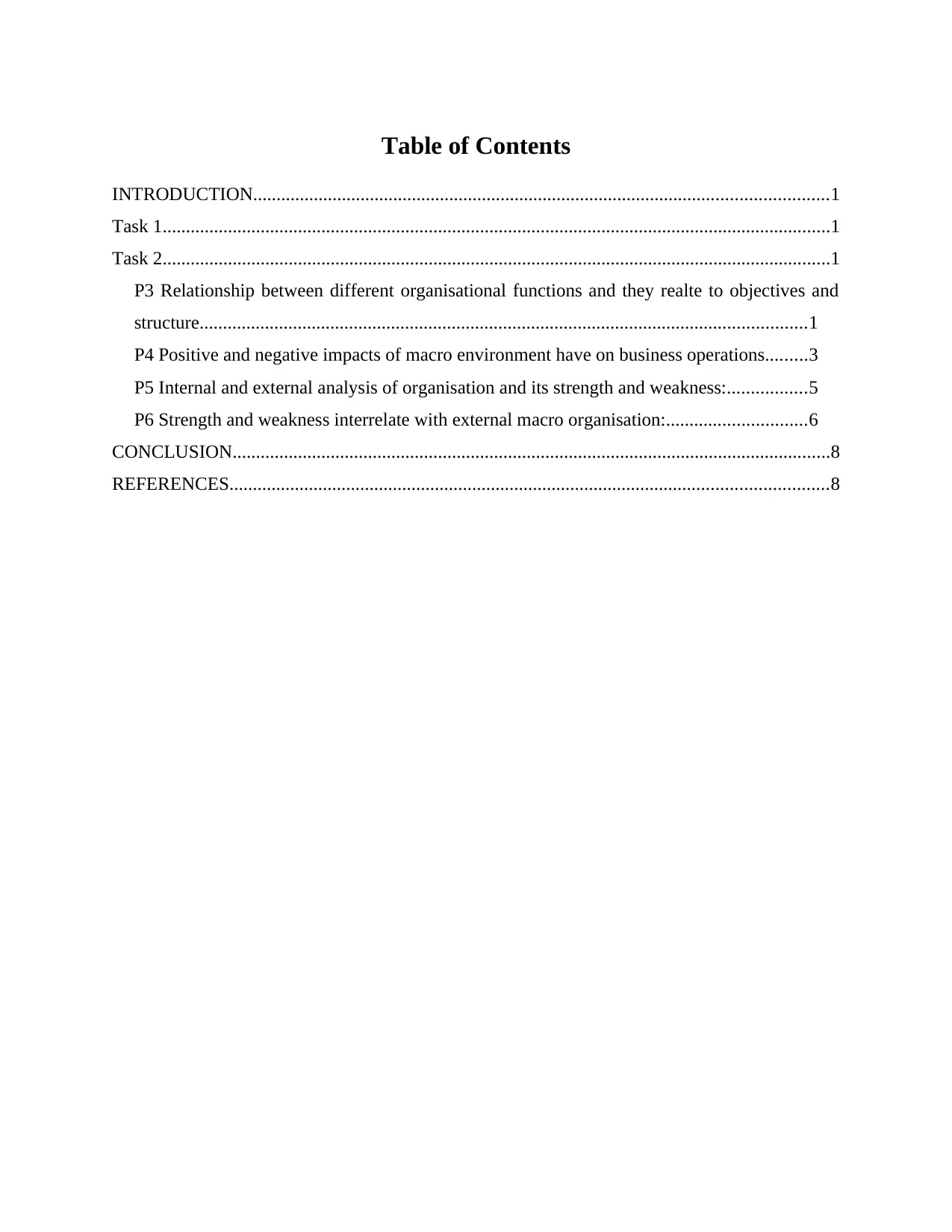
Table of Contents
INTRODUCTION...........................................................................................................................1
Task 1...............................................................................................................................................1
Task 2...............................................................................................................................................1
P3 Relationship between different organisational functions and they realte to objectives and
structure..................................................................................................................................1
P4 Positive and negative impacts of macro environment have on business operations.........3
P5 Internal and external analysis of organisation and its strength and weakness:.................5
P6 Strength and weakness interrelate with external macro organisation:..............................6
CONCLUSION................................................................................................................................8
REFERENCES................................................................................................................................8
INTRODUCTION...........................................................................................................................1
Task 1...............................................................................................................................................1
Task 2...............................................................................................................................................1
P3 Relationship between different organisational functions and they realte to objectives and
structure..................................................................................................................................1
P4 Positive and negative impacts of macro environment have on business operations.........3
P5 Internal and external analysis of organisation and its strength and weakness:.................5
P6 Strength and weakness interrelate with external macro organisation:..............................6
CONCLUSION................................................................................................................................8
REFERENCES................................................................................................................................8
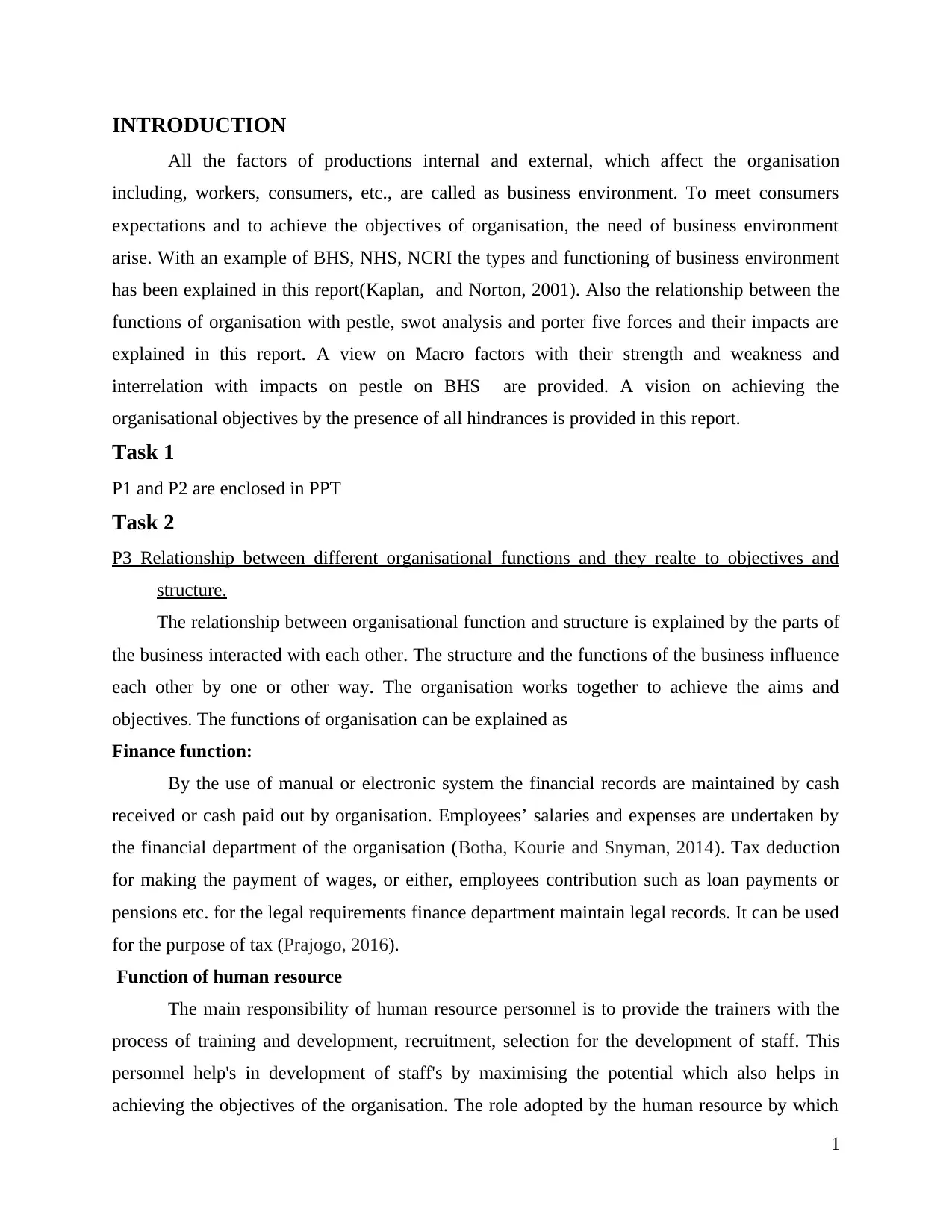
INTRODUCTION
All the factors of productions internal and external, which affect the organisation
including, workers, consumers, etc., are called as business environment. To meet consumers
expectations and to achieve the objectives of organisation, the need of business environment
arise. With an example of BHS, NHS, NCRI the types and functioning of business environment
has been explained in this report(Kaplan, and Norton, 2001). Also the relationship between the
functions of organisation with pestle, swot analysis and porter five forces and their impacts are
explained in this report. A view on Macro factors with their strength and weakness and
interrelation with impacts on pestle on BHS are provided. A vision on achieving the
organisational objectives by the presence of all hindrances is provided in this report.
Task 1
P1 and P2 are enclosed in PPT
Task 2
P3 Relationship between different organisational functions and they realte to objectives and
structure.
The relationship between organisational function and structure is explained by the parts of
the business interacted with each other. The structure and the functions of the business influence
each other by one or other way. The organisation works together to achieve the aims and
objectives. The functions of organisation can be explained as
Finance function:
By the use of manual or electronic system the financial records are maintained by cash
received or cash paid out by organisation. Employees’ salaries and expenses are undertaken by
the financial department of the organisation (Botha, Kourie and Snyman, 2014). Tax deduction
for making the payment of wages, or either, employees contribution such as loan payments or
pensions etc. for the legal requirements finance department maintain legal records. It can be used
for the purpose of tax (Prajogo, 2016).
Function of human resource
The main responsibility of human resource personnel is to provide the trainers with the
process of training and development, recruitment, selection for the development of staff. This
personnel help's in development of staff's by maximising the potential which also helps in
achieving the objectives of the organisation. The role adopted by the human resource by which
1
All the factors of productions internal and external, which affect the organisation
including, workers, consumers, etc., are called as business environment. To meet consumers
expectations and to achieve the objectives of organisation, the need of business environment
arise. With an example of BHS, NHS, NCRI the types and functioning of business environment
has been explained in this report(Kaplan, and Norton, 2001). Also the relationship between the
functions of organisation with pestle, swot analysis and porter five forces and their impacts are
explained in this report. A view on Macro factors with their strength and weakness and
interrelation with impacts on pestle on BHS are provided. A vision on achieving the
organisational objectives by the presence of all hindrances is provided in this report.
Task 1
P1 and P2 are enclosed in PPT
Task 2
P3 Relationship between different organisational functions and they realte to objectives and
structure.
The relationship between organisational function and structure is explained by the parts of
the business interacted with each other. The structure and the functions of the business influence
each other by one or other way. The organisation works together to achieve the aims and
objectives. The functions of organisation can be explained as
Finance function:
By the use of manual or electronic system the financial records are maintained by cash
received or cash paid out by organisation. Employees’ salaries and expenses are undertaken by
the financial department of the organisation (Botha, Kourie and Snyman, 2014). Tax deduction
for making the payment of wages, or either, employees contribution such as loan payments or
pensions etc. for the legal requirements finance department maintain legal records. It can be used
for the purpose of tax (Prajogo, 2016).
Function of human resource
The main responsibility of human resource personnel is to provide the trainers with the
process of training and development, recruitment, selection for the development of staff. This
personnel help's in development of staff's by maximising the potential which also helps in
achieving the objectives of the organisation. The role adopted by the human resource by which
1
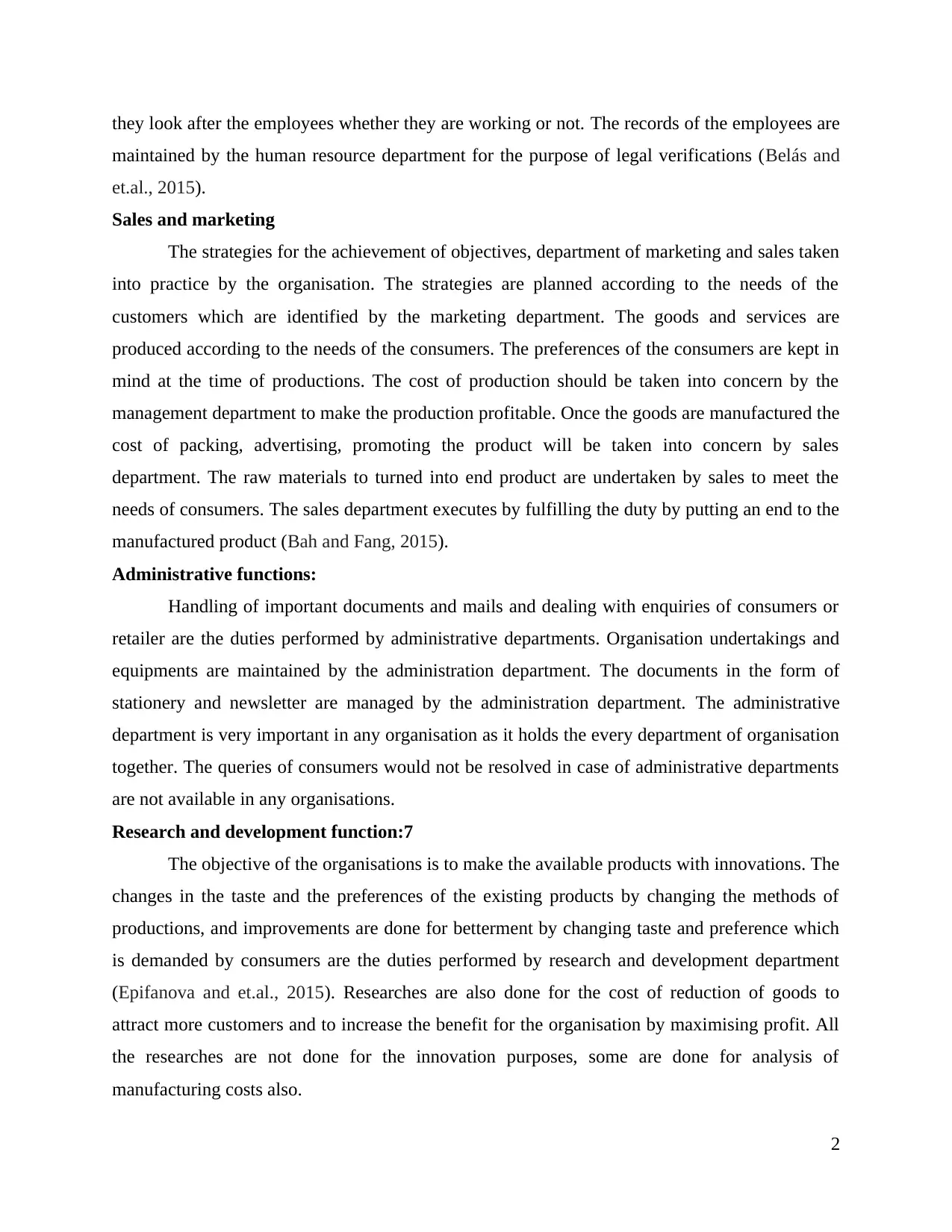
they look after the employees whether they are working or not. The records of the employees are
maintained by the human resource department for the purpose of legal verifications (Belás and
et.al., 2015).
Sales and marketing
The strategies for the achievement of objectives, department of marketing and sales taken
into practice by the organisation. The strategies are planned according to the needs of the
customers which are identified by the marketing department. The goods and services are
produced according to the needs of the consumers. The preferences of the consumers are kept in
mind at the time of productions. The cost of production should be taken into concern by the
management department to make the production profitable. Once the goods are manufactured the
cost of packing, advertising, promoting the product will be taken into concern by sales
department. The raw materials to turned into end product are undertaken by sales to meet the
needs of consumers. The sales department executes by fulfilling the duty by putting an end to the
manufactured product (Bah and Fang, 2015).
Administrative functions:
Handling of important documents and mails and dealing with enquiries of consumers or
retailer are the duties performed by administrative departments. Organisation undertakings and
equipments are maintained by the administration department. The documents in the form of
stationery and newsletter are managed by the administration department. The administrative
department is very important in any organisation as it holds the every department of organisation
together. The queries of consumers would not be resolved in case of administrative departments
are not available in any organisations.
Research and development function:7
The objective of the organisations is to make the available products with innovations. The
changes in the taste and the preferences of the existing products by changing the methods of
productions, and improvements are done for betterment by changing taste and preference which
is demanded by consumers are the duties performed by research and development department
(Epifanova and et.al., 2015). Researches are also done for the cost of reduction of goods to
attract more customers and to increase the benefit for the organisation by maximising profit. All
the researches are not done for the innovation purposes, some are done for analysis of
manufacturing costs also.
2
maintained by the human resource department for the purpose of legal verifications (Belás and
et.al., 2015).
Sales and marketing
The strategies for the achievement of objectives, department of marketing and sales taken
into practice by the organisation. The strategies are planned according to the needs of the
customers which are identified by the marketing department. The goods and services are
produced according to the needs of the consumers. The preferences of the consumers are kept in
mind at the time of productions. The cost of production should be taken into concern by the
management department to make the production profitable. Once the goods are manufactured the
cost of packing, advertising, promoting the product will be taken into concern by sales
department. The raw materials to turned into end product are undertaken by sales to meet the
needs of consumers. The sales department executes by fulfilling the duty by putting an end to the
manufactured product (Bah and Fang, 2015).
Administrative functions:
Handling of important documents and mails and dealing with enquiries of consumers or
retailer are the duties performed by administrative departments. Organisation undertakings and
equipments are maintained by the administration department. The documents in the form of
stationery and newsletter are managed by the administration department. The administrative
department is very important in any organisation as it holds the every department of organisation
together. The queries of consumers would not be resolved in case of administrative departments
are not available in any organisations.
Research and development function:7
The objective of the organisations is to make the available products with innovations. The
changes in the taste and the preferences of the existing products by changing the methods of
productions, and improvements are done for betterment by changing taste and preference which
is demanded by consumers are the duties performed by research and development department
(Epifanova and et.al., 2015). Researches are also done for the cost of reduction of goods to
attract more customers and to increase the benefit for the organisation by maximising profit. All
the researches are not done for the innovation purposes, some are done for analysis of
manufacturing costs also.
2
Secure Best Marks with AI Grader
Need help grading? Try our AI Grader for instant feedback on your assignments.
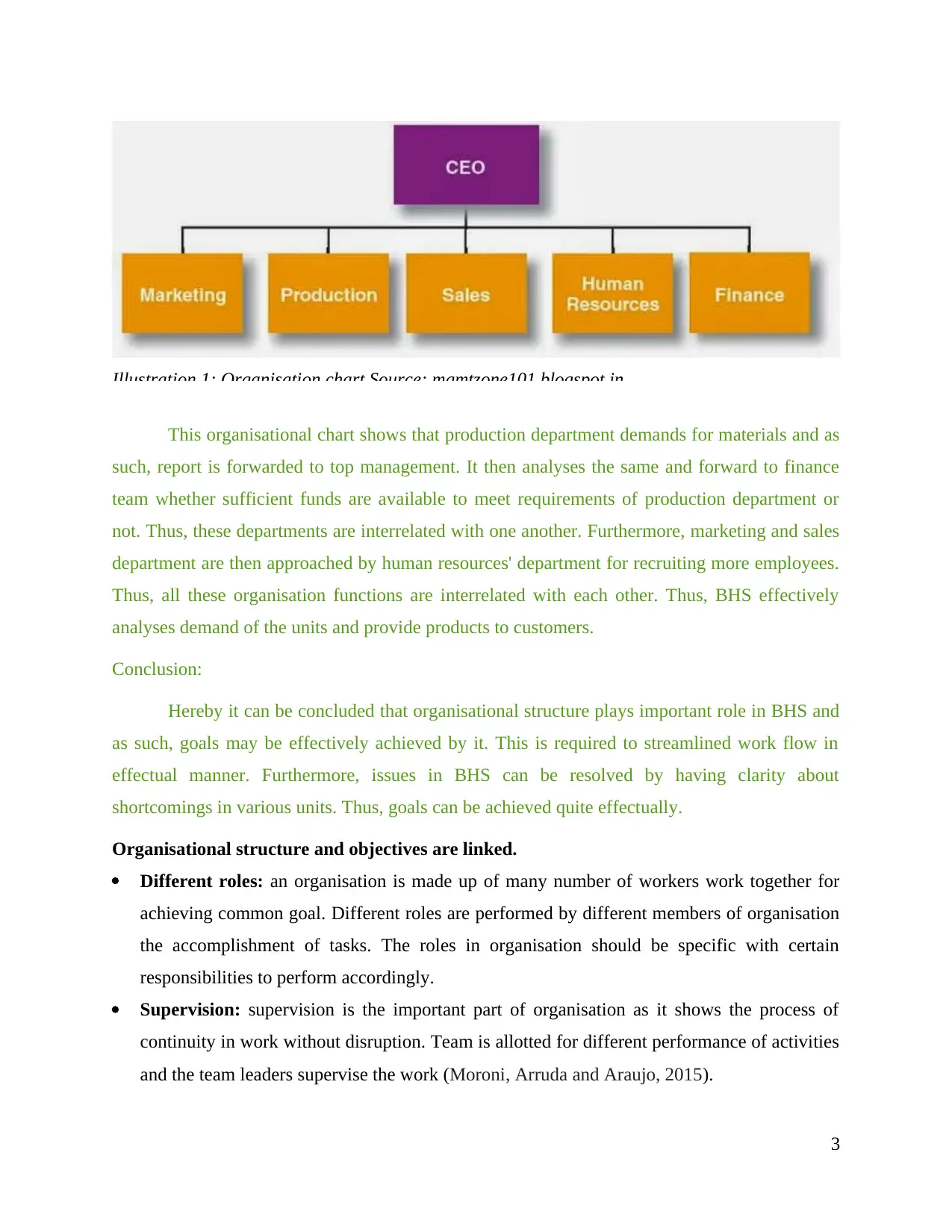
This organisational chart shows that production department demands for materials and as
such, report is forwarded to top management. It then analyses the same and forward to finance
team whether sufficient funds are available to meet requirements of production department or
not. Thus, these departments are interrelated with one another. Furthermore, marketing and sales
department are then approached by human resources' department for recruiting more employees.
Thus, all these organisation functions are interrelated with each other. Thus, BHS effectively
analyses demand of the units and provide products to customers.
Conclusion:
Hereby it can be concluded that organisational structure plays important role in BHS and
as such, goals may be effectively achieved by it. This is required to streamlined work flow in
effectual manner. Furthermore, issues in BHS can be resolved by having clarity about
shortcomings in various units. Thus, goals can be achieved quite effectually.
Organisational structure and objectives are linked.
Different roles: an organisation is made up of many number of workers work together for
achieving common goal. Different roles are performed by different members of organisation
the accomplishment of tasks. The roles in organisation should be specific with certain
responsibilities to perform accordingly.
Supervision: supervision is the important part of organisation as it shows the process of
continuity in work without disruption. Team is allotted for different performance of activities
and the team leaders supervise the work (Moroni, Arruda and Araujo, 2015).
3
Illustration 1: Organisation chart Source: mgmtzone101.blogspot.in
such, report is forwarded to top management. It then analyses the same and forward to finance
team whether sufficient funds are available to meet requirements of production department or
not. Thus, these departments are interrelated with one another. Furthermore, marketing and sales
department are then approached by human resources' department for recruiting more employees.
Thus, all these organisation functions are interrelated with each other. Thus, BHS effectively
analyses demand of the units and provide products to customers.
Conclusion:
Hereby it can be concluded that organisational structure plays important role in BHS and
as such, goals may be effectively achieved by it. This is required to streamlined work flow in
effectual manner. Furthermore, issues in BHS can be resolved by having clarity about
shortcomings in various units. Thus, goals can be achieved quite effectually.
Organisational structure and objectives are linked.
Different roles: an organisation is made up of many number of workers work together for
achieving common goal. Different roles are performed by different members of organisation
the accomplishment of tasks. The roles in organisation should be specific with certain
responsibilities to perform accordingly.
Supervision: supervision is the important part of organisation as it shows the process of
continuity in work without disruption. Team is allotted for different performance of activities
and the team leaders supervise the work (Moroni, Arruda and Araujo, 2015).
3
Illustration 1: Organisation chart Source: mgmtzone101.blogspot.in
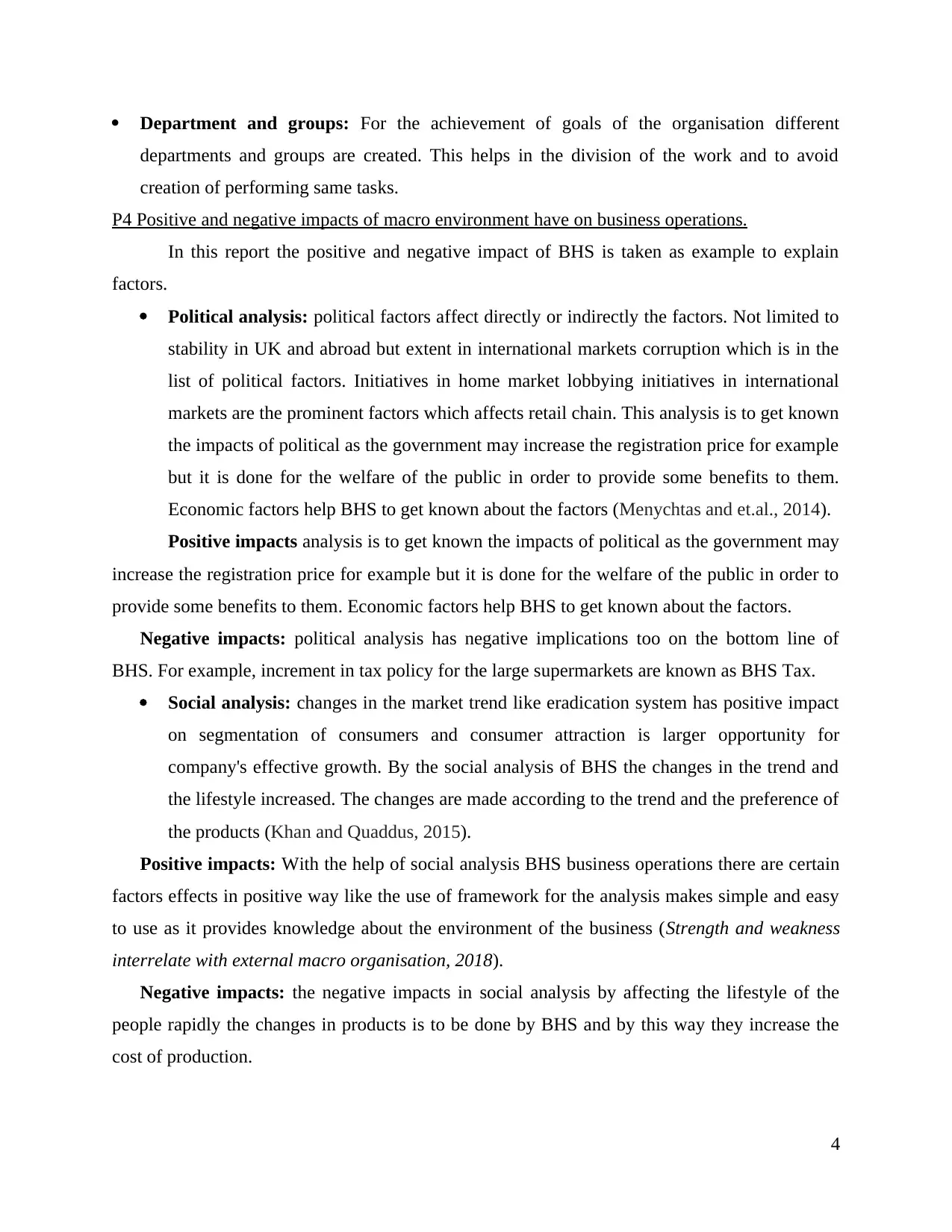
Department and groups: For the achievement of goals of the organisation different
departments and groups are created. This helps in the division of the work and to avoid
creation of performing same tasks.
P4 Positive and negative impacts of macro environment have on business operations.
In this report the positive and negative impact of BHS is taken as example to explain
factors.
Political analysis: political factors affect directly or indirectly the factors. Not limited to
stability in UK and abroad but extent in international markets corruption which is in the
list of political factors. Initiatives in home market lobbying initiatives in international
markets are the prominent factors which affects retail chain. This analysis is to get known
the impacts of political as the government may increase the registration price for example
but it is done for the welfare of the public in order to provide some benefits to them.
Economic factors help BHS to get known about the factors (Menychtas and et.al., 2014).
Positive impacts analysis is to get known the impacts of political as the government may
increase the registration price for example but it is done for the welfare of the public in order to
provide some benefits to them. Economic factors help BHS to get known about the factors.
Negative impacts: political analysis has negative implications too on the bottom line of
BHS. For example, increment in tax policy for the large supermarkets are known as BHS Tax.
Social analysis: changes in the market trend like eradication system has positive impact
on segmentation of consumers and consumer attraction is larger opportunity for
company's effective growth. By the social analysis of BHS the changes in the trend and
the lifestyle increased. The changes are made according to the trend and the preference of
the products (Khan and Quaddus, 2015).
Positive impacts: With the help of social analysis BHS business operations there are certain
factors effects in positive way like the use of framework for the analysis makes simple and easy
to use as it provides knowledge about the environment of the business (Strength and weakness
interrelate with external macro organisation, 2018).
Negative impacts: the negative impacts in social analysis by affecting the lifestyle of the
people rapidly the changes in products is to be done by BHS and by this way they increase the
cost of production.
4
departments and groups are created. This helps in the division of the work and to avoid
creation of performing same tasks.
P4 Positive and negative impacts of macro environment have on business operations.
In this report the positive and negative impact of BHS is taken as example to explain
factors.
Political analysis: political factors affect directly or indirectly the factors. Not limited to
stability in UK and abroad but extent in international markets corruption which is in the
list of political factors. Initiatives in home market lobbying initiatives in international
markets are the prominent factors which affects retail chain. This analysis is to get known
the impacts of political as the government may increase the registration price for example
but it is done for the welfare of the public in order to provide some benefits to them.
Economic factors help BHS to get known about the factors (Menychtas and et.al., 2014).
Positive impacts analysis is to get known the impacts of political as the government may
increase the registration price for example but it is done for the welfare of the public in order to
provide some benefits to them. Economic factors help BHS to get known about the factors.
Negative impacts: political analysis has negative implications too on the bottom line of
BHS. For example, increment in tax policy for the large supermarkets are known as BHS Tax.
Social analysis: changes in the market trend like eradication system has positive impact
on segmentation of consumers and consumer attraction is larger opportunity for
company's effective growth. By the social analysis of BHS the changes in the trend and
the lifestyle increased. The changes are made according to the trend and the preference of
the products (Khan and Quaddus, 2015).
Positive impacts: With the help of social analysis BHS business operations there are certain
factors effects in positive way like the use of framework for the analysis makes simple and easy
to use as it provides knowledge about the environment of the business (Strength and weakness
interrelate with external macro organisation, 2018).
Negative impacts: the negative impacts in social analysis by affecting the lifestyle of the
people rapidly the changes in products is to be done by BHS and by this way they increase the
cost of production.
4
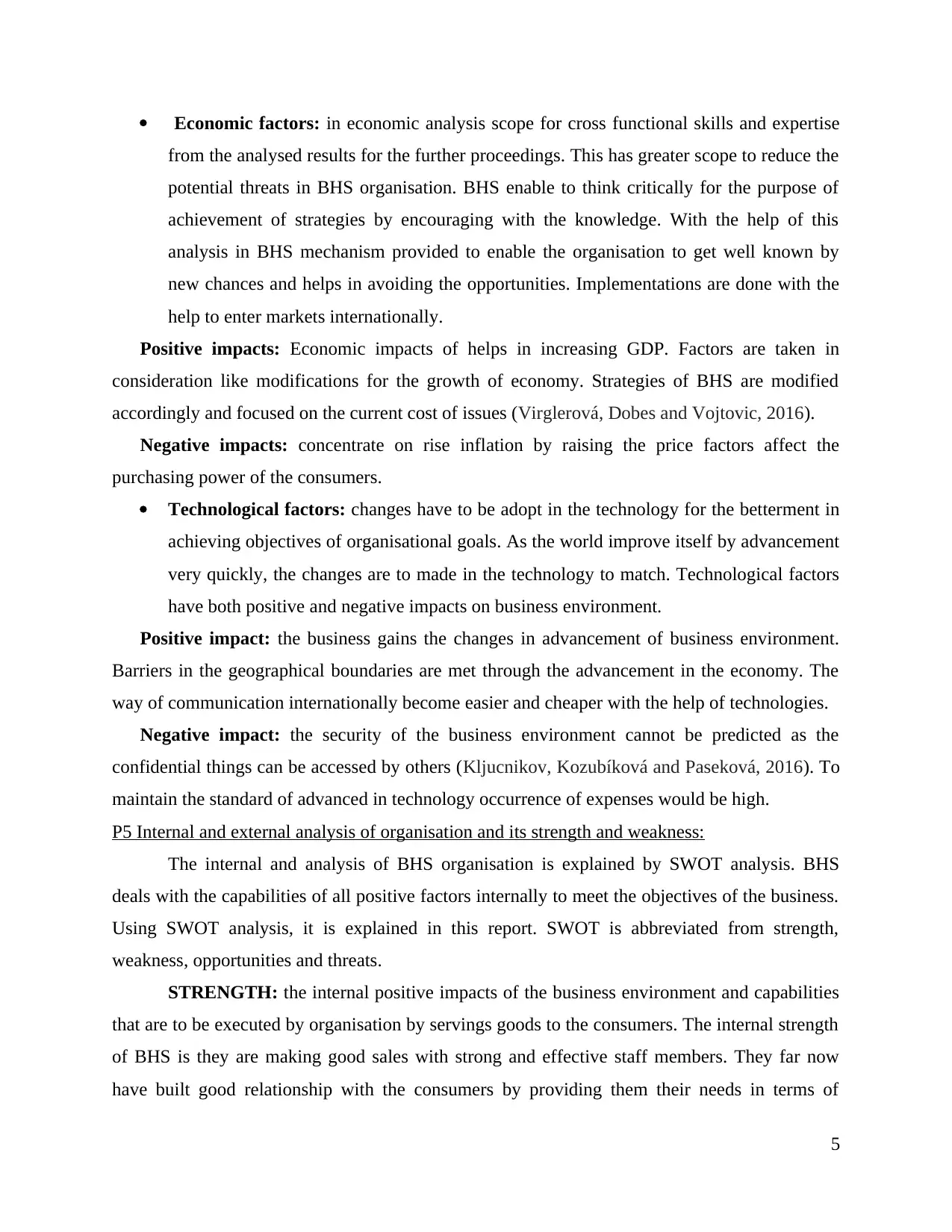
Economic factors: in economic analysis scope for cross functional skills and expertise
from the analysed results for the further proceedings. This has greater scope to reduce the
potential threats in BHS organisation. BHS enable to think critically for the purpose of
achievement of strategies by encouraging with the knowledge. With the help of this
analysis in BHS mechanism provided to enable the organisation to get well known by
new chances and helps in avoiding the opportunities. Implementations are done with the
help to enter markets internationally.
Positive impacts: Economic impacts of helps in increasing GDP. Factors are taken in
consideration like modifications for the growth of economy. Strategies of BHS are modified
accordingly and focused on the current cost of issues (Virglerová, Dobes and Vojtovic, 2016).
Negative impacts: concentrate on rise inflation by raising the price factors affect the
purchasing power of the consumers.
Technological factors: changes have to be adopt in the technology for the betterment in
achieving objectives of organisational goals. As the world improve itself by advancement
very quickly, the changes are to made in the technology to match. Technological factors
have both positive and negative impacts on business environment.
Positive impact: the business gains the changes in advancement of business environment.
Barriers in the geographical boundaries are met through the advancement in the economy. The
way of communication internationally become easier and cheaper with the help of technologies.
Negative impact: the security of the business environment cannot be predicted as the
confidential things can be accessed by others (Kljucnikov, Kozubíková and Paseková, 2016). To
maintain the standard of advanced in technology occurrence of expenses would be high.
P5 Internal and external analysis of organisation and its strength and weakness:
The internal and analysis of BHS organisation is explained by SWOT analysis. BHS
deals with the capabilities of all positive factors internally to meet the objectives of the business.
Using SWOT analysis, it is explained in this report. SWOT is abbreviated from strength,
weakness, opportunities and threats.
STRENGTH: the internal positive impacts of the business environment and capabilities
that are to be executed by organisation by servings goods to the consumers. The internal strength
of BHS is they are making good sales with strong and effective staff members. They far now
have built good relationship with the consumers by providing them their needs in terms of
5
from the analysed results for the further proceedings. This has greater scope to reduce the
potential threats in BHS organisation. BHS enable to think critically for the purpose of
achievement of strategies by encouraging with the knowledge. With the help of this
analysis in BHS mechanism provided to enable the organisation to get well known by
new chances and helps in avoiding the opportunities. Implementations are done with the
help to enter markets internationally.
Positive impacts: Economic impacts of helps in increasing GDP. Factors are taken in
consideration like modifications for the growth of economy. Strategies of BHS are modified
accordingly and focused on the current cost of issues (Virglerová, Dobes and Vojtovic, 2016).
Negative impacts: concentrate on rise inflation by raising the price factors affect the
purchasing power of the consumers.
Technological factors: changes have to be adopt in the technology for the betterment in
achieving objectives of organisational goals. As the world improve itself by advancement
very quickly, the changes are to made in the technology to match. Technological factors
have both positive and negative impacts on business environment.
Positive impact: the business gains the changes in advancement of business environment.
Barriers in the geographical boundaries are met through the advancement in the economy. The
way of communication internationally become easier and cheaper with the help of technologies.
Negative impact: the security of the business environment cannot be predicted as the
confidential things can be accessed by others (Kljucnikov, Kozubíková and Paseková, 2016). To
maintain the standard of advanced in technology occurrence of expenses would be high.
P5 Internal and external analysis of organisation and its strength and weakness:
The internal and analysis of BHS organisation is explained by SWOT analysis. BHS
deals with the capabilities of all positive factors internally to meet the objectives of the business.
Using SWOT analysis, it is explained in this report. SWOT is abbreviated from strength,
weakness, opportunities and threats.
STRENGTH: the internal positive impacts of the business environment and capabilities
that are to be executed by organisation by servings goods to the consumers. The internal strength
of BHS is they are making good sales with strong and effective staff members. They far now
have built good relationship with the consumers by providing them their needs in terms of
5
Paraphrase This Document
Need a fresh take? Get an instant paraphrase of this document with our AI Paraphraser
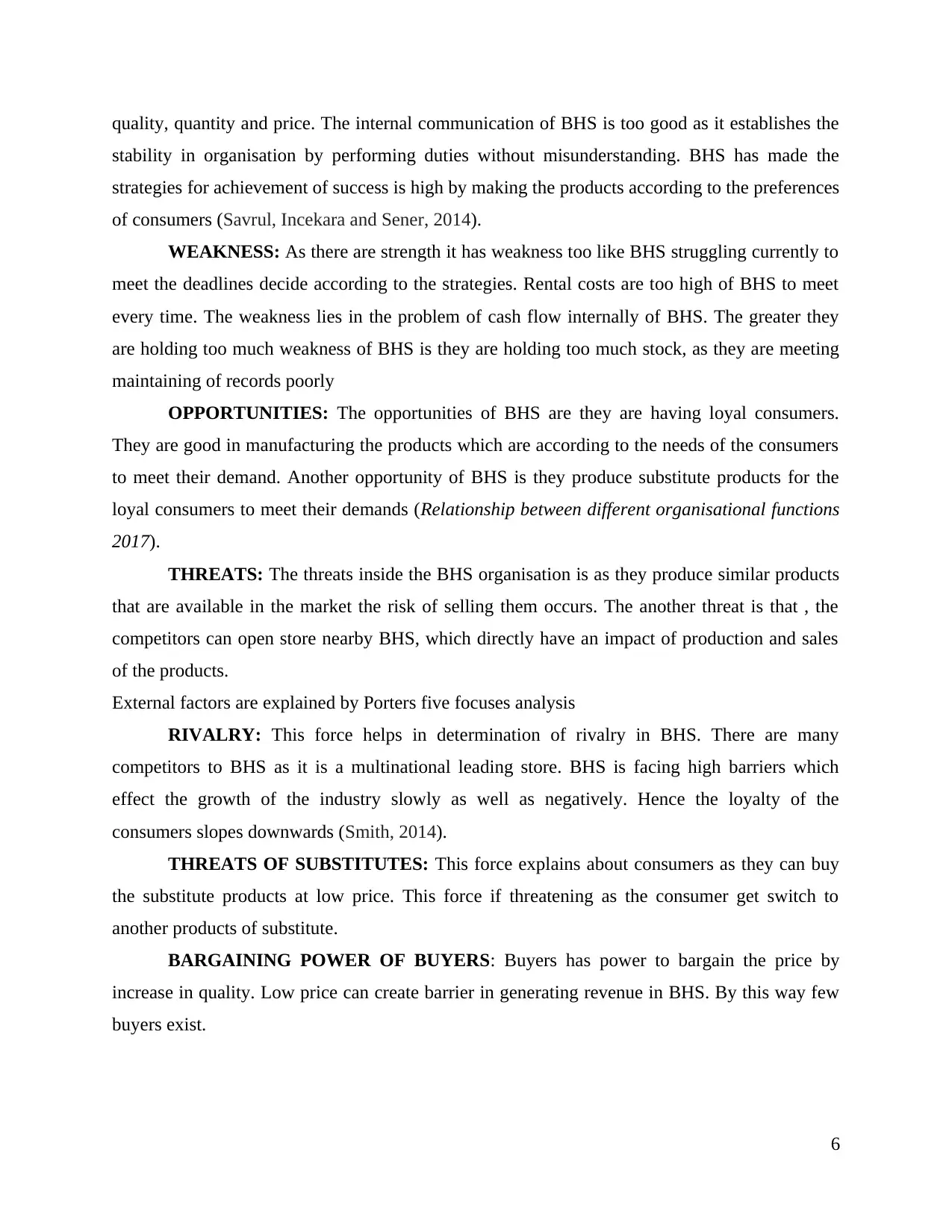
quality, quantity and price. The internal communication of BHS is too good as it establishes the
stability in organisation by performing duties without misunderstanding. BHS has made the
strategies for achievement of success is high by making the products according to the preferences
of consumers (Savrul, Incekara and Sener, 2014).
WEAKNESS: As there are strength it has weakness too like BHS struggling currently to
meet the deadlines decide according to the strategies. Rental costs are too high of BHS to meet
every time. The weakness lies in the problem of cash flow internally of BHS. The greater they
are holding too much weakness of BHS is they are holding too much stock, as they are meeting
maintaining of records poorly
OPPORTUNITIES: The opportunities of BHS are they are having loyal consumers.
They are good in manufacturing the products which are according to the needs of the consumers
to meet their demand. Another opportunity of BHS is they produce substitute products for the
loyal consumers to meet their demands (Relationship between different organisational functions
2017).
THREATS: The threats inside the BHS organisation is as they produce similar products
that are available in the market the risk of selling them occurs. The another threat is that , the
competitors can open store nearby BHS, which directly have an impact of production and sales
of the products.
External factors are explained by Porters five focuses analysis
RIVALRY: This force helps in determination of rivalry in BHS. There are many
competitors to BHS as it is a multinational leading store. BHS is facing high barriers which
effect the growth of the industry slowly as well as negatively. Hence the loyalty of the
consumers slopes downwards (Smith, 2014).
THREATS OF SUBSTITUTES: This force explains about consumers as they can buy
the substitute products at low price. This force if threatening as the consumer get switch to
another products of substitute.
BARGAINING POWER OF BUYERS: Buyers has power to bargain the price by
increase in quality. Low price can create barrier in generating revenue in BHS. By this way few
buyers exist.
6
stability in organisation by performing duties without misunderstanding. BHS has made the
strategies for achievement of success is high by making the products according to the preferences
of consumers (Savrul, Incekara and Sener, 2014).
WEAKNESS: As there are strength it has weakness too like BHS struggling currently to
meet the deadlines decide according to the strategies. Rental costs are too high of BHS to meet
every time. The weakness lies in the problem of cash flow internally of BHS. The greater they
are holding too much weakness of BHS is they are holding too much stock, as they are meeting
maintaining of records poorly
OPPORTUNITIES: The opportunities of BHS are they are having loyal consumers.
They are good in manufacturing the products which are according to the needs of the consumers
to meet their demand. Another opportunity of BHS is they produce substitute products for the
loyal consumers to meet their demands (Relationship between different organisational functions
2017).
THREATS: The threats inside the BHS organisation is as they produce similar products
that are available in the market the risk of selling them occurs. The another threat is that , the
competitors can open store nearby BHS, which directly have an impact of production and sales
of the products.
External factors are explained by Porters five focuses analysis
RIVALRY: This force helps in determination of rivalry in BHS. There are many
competitors to BHS as it is a multinational leading store. BHS is facing high barriers which
effect the growth of the industry slowly as well as negatively. Hence the loyalty of the
consumers slopes downwards (Smith, 2014).
THREATS OF SUBSTITUTES: This force explains about consumers as they can buy
the substitute products at low price. This force if threatening as the consumer get switch to
another products of substitute.
BARGAINING POWER OF BUYERS: Buyers has power to bargain the price by
increase in quality. Low price can create barrier in generating revenue in BHS. By this way few
buyers exist.
6
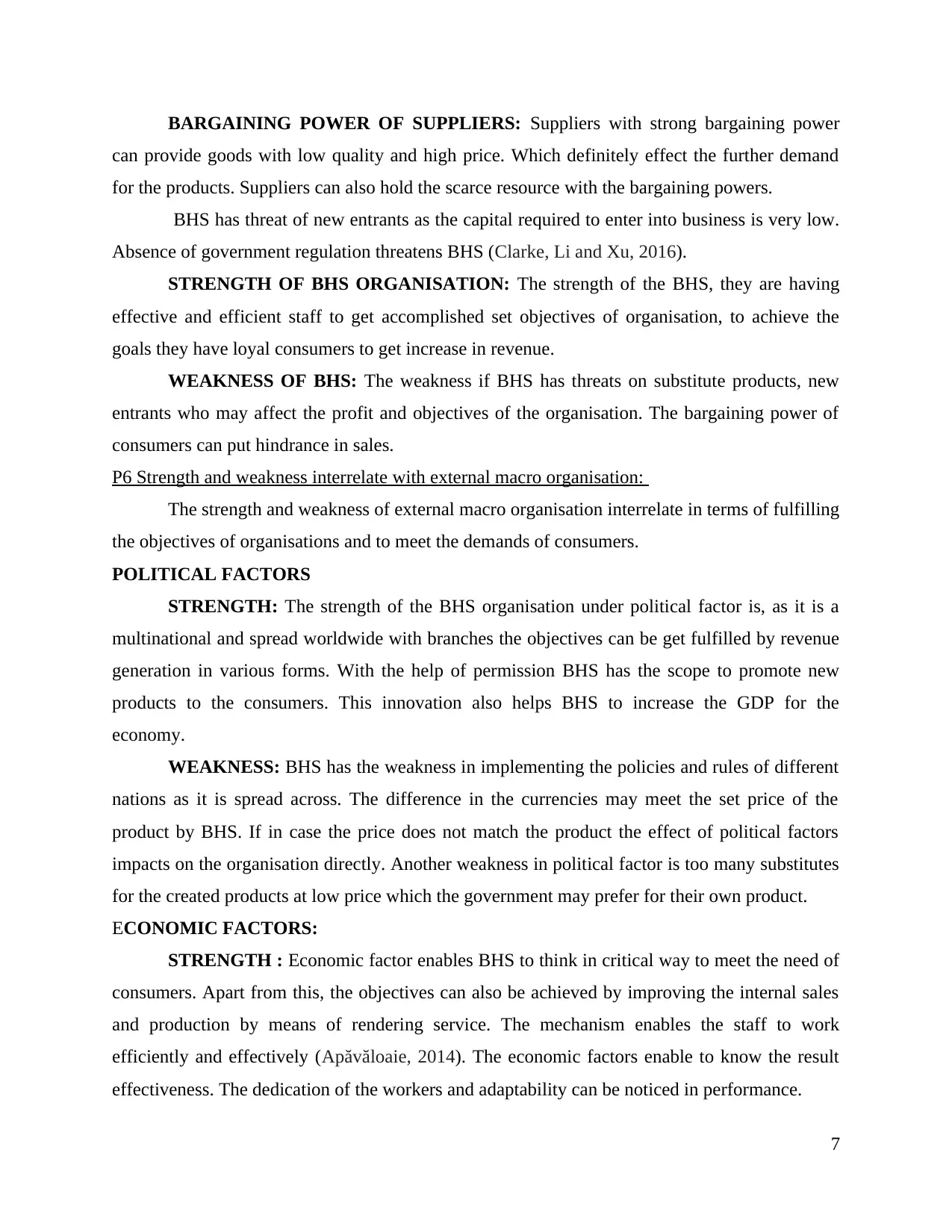
BARGAINING POWER OF SUPPLIERS: Suppliers with strong bargaining power
can provide goods with low quality and high price. Which definitely effect the further demand
for the products. Suppliers can also hold the scarce resource with the bargaining powers.
BHS has threat of new entrants as the capital required to enter into business is very low.
Absence of government regulation threatens BHS (Clarke, Li and Xu, 2016).
STRENGTH OF BHS ORGANISATION: The strength of the BHS, they are having
effective and efficient staff to get accomplished set objectives of organisation, to achieve the
goals they have loyal consumers to get increase in revenue.
WEAKNESS OF BHS: The weakness if BHS has threats on substitute products, new
entrants who may affect the profit and objectives of the organisation. The bargaining power of
consumers can put hindrance in sales.
P6 Strength and weakness interrelate with external macro organisation:
The strength and weakness of external macro organisation interrelate in terms of fulfilling
the objectives of organisations and to meet the demands of consumers.
POLITICAL FACTORS
STRENGTH: The strength of the BHS organisation under political factor is, as it is a
multinational and spread worldwide with branches the objectives can be get fulfilled by revenue
generation in various forms. With the help of permission BHS has the scope to promote new
products to the consumers. This innovation also helps BHS to increase the GDP for the
economy.
WEAKNESS: BHS has the weakness in implementing the policies and rules of different
nations as it is spread across. The difference in the currencies may meet the set price of the
product by BHS. If in case the price does not match the product the effect of political factors
impacts on the organisation directly. Another weakness in political factor is too many substitutes
for the created products at low price which the government may prefer for their own product.
ECONOMIC FACTORS:
STRENGTH : Economic factor enables BHS to think in critical way to meet the need of
consumers. Apart from this, the objectives can also be achieved by improving the internal sales
and production by means of rendering service. The mechanism enables the staff to work
efficiently and effectively (Apăvăloaie, 2014). The economic factors enable to know the result
effectiveness. The dedication of the workers and adaptability can be noticed in performance.
7
can provide goods with low quality and high price. Which definitely effect the further demand
for the products. Suppliers can also hold the scarce resource with the bargaining powers.
BHS has threat of new entrants as the capital required to enter into business is very low.
Absence of government regulation threatens BHS (Clarke, Li and Xu, 2016).
STRENGTH OF BHS ORGANISATION: The strength of the BHS, they are having
effective and efficient staff to get accomplished set objectives of organisation, to achieve the
goals they have loyal consumers to get increase in revenue.
WEAKNESS OF BHS: The weakness if BHS has threats on substitute products, new
entrants who may affect the profit and objectives of the organisation. The bargaining power of
consumers can put hindrance in sales.
P6 Strength and weakness interrelate with external macro organisation:
The strength and weakness of external macro organisation interrelate in terms of fulfilling
the objectives of organisations and to meet the demands of consumers.
POLITICAL FACTORS
STRENGTH: The strength of the BHS organisation under political factor is, as it is a
multinational and spread worldwide with branches the objectives can be get fulfilled by revenue
generation in various forms. With the help of permission BHS has the scope to promote new
products to the consumers. This innovation also helps BHS to increase the GDP for the
economy.
WEAKNESS: BHS has the weakness in implementing the policies and rules of different
nations as it is spread across. The difference in the currencies may meet the set price of the
product by BHS. If in case the price does not match the product the effect of political factors
impacts on the organisation directly. Another weakness in political factor is too many substitutes
for the created products at low price which the government may prefer for their own product.
ECONOMIC FACTORS:
STRENGTH : Economic factor enables BHS to think in critical way to meet the need of
consumers. Apart from this, the objectives can also be achieved by improving the internal sales
and production by means of rendering service. The mechanism enables the staff to work
efficiently and effectively (Apăvăloaie, 2014). The economic factors enable to know the result
effectiveness. The dedication of the workers and adaptability can be noticed in performance.
7
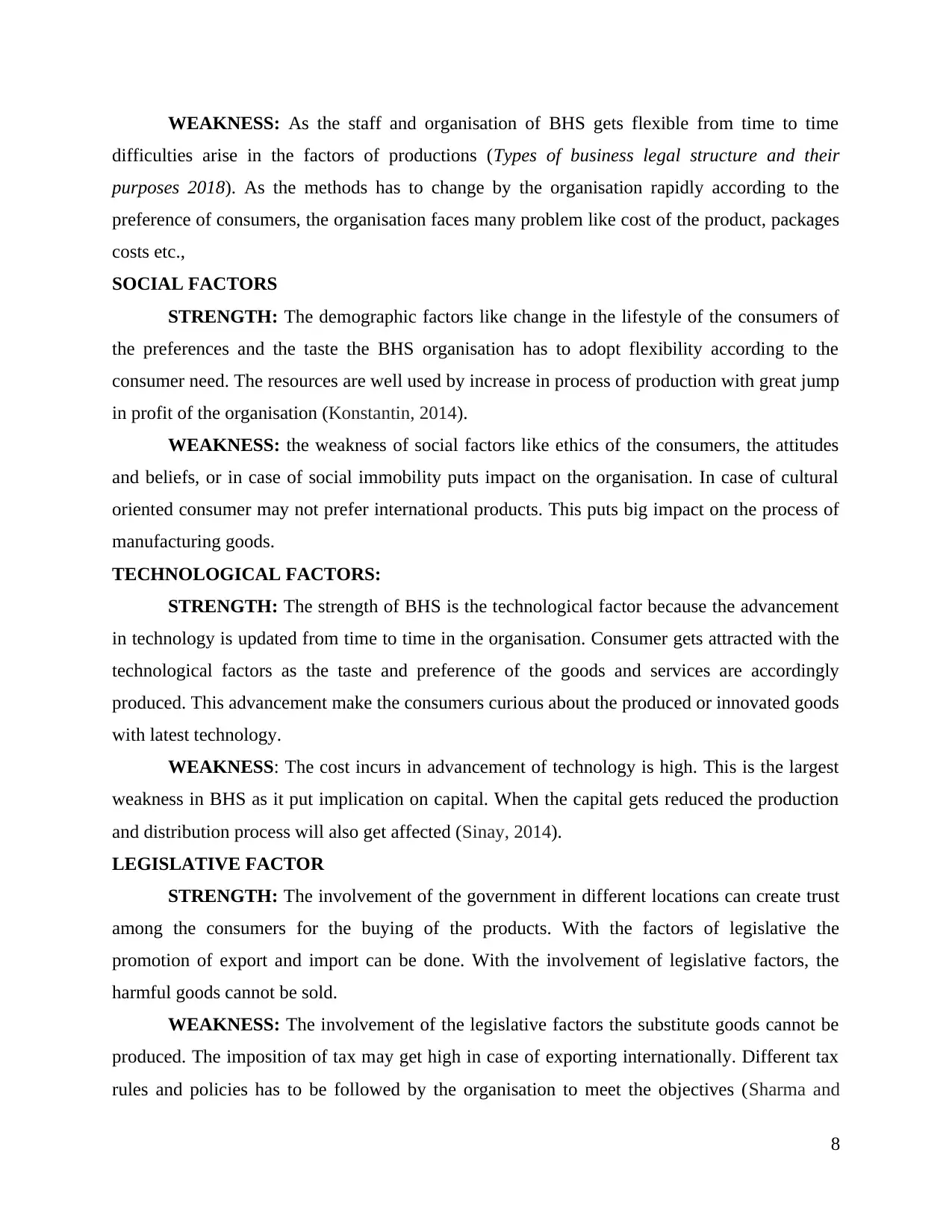
WEAKNESS: As the staff and organisation of BHS gets flexible from time to time
difficulties arise in the factors of productions (Types of business legal structure and their
purposes 2018). As the methods has to change by the organisation rapidly according to the
preference of consumers, the organisation faces many problem like cost of the product, packages
costs etc.,
SOCIAL FACTORS
STRENGTH: The demographic factors like change in the lifestyle of the consumers of
the preferences and the taste the BHS organisation has to adopt flexibility according to the
consumer need. The resources are well used by increase in process of production with great jump
in profit of the organisation (Konstantin, 2014).
WEAKNESS: the weakness of social factors like ethics of the consumers, the attitudes
and beliefs, or in case of social immobility puts impact on the organisation. In case of cultural
oriented consumer may not prefer international products. This puts big impact on the process of
manufacturing goods.
TECHNOLOGICAL FACTORS:
STRENGTH: The strength of BHS is the technological factor because the advancement
in technology is updated from time to time in the organisation. Consumer gets attracted with the
technological factors as the taste and preference of the goods and services are accordingly
produced. This advancement make the consumers curious about the produced or innovated goods
with latest technology.
WEAKNESS: The cost incurs in advancement of technology is high. This is the largest
weakness in BHS as it put implication on capital. When the capital gets reduced the production
and distribution process will also get affected (Sinay, 2014).
LEGISLATIVE FACTOR
STRENGTH: The involvement of the government in different locations can create trust
among the consumers for the buying of the products. With the factors of legislative the
promotion of export and import can be done. With the involvement of legislative factors, the
harmful goods cannot be sold.
WEAKNESS: The involvement of the legislative factors the substitute goods cannot be
produced. The imposition of tax may get high in case of exporting internationally. Different tax
rules and policies has to be followed by the organisation to meet the objectives (Sharma and
8
difficulties arise in the factors of productions (Types of business legal structure and their
purposes 2018). As the methods has to change by the organisation rapidly according to the
preference of consumers, the organisation faces many problem like cost of the product, packages
costs etc.,
SOCIAL FACTORS
STRENGTH: The demographic factors like change in the lifestyle of the consumers of
the preferences and the taste the BHS organisation has to adopt flexibility according to the
consumer need. The resources are well used by increase in process of production with great jump
in profit of the organisation (Konstantin, 2014).
WEAKNESS: the weakness of social factors like ethics of the consumers, the attitudes
and beliefs, or in case of social immobility puts impact on the organisation. In case of cultural
oriented consumer may not prefer international products. This puts big impact on the process of
manufacturing goods.
TECHNOLOGICAL FACTORS:
STRENGTH: The strength of BHS is the technological factor because the advancement
in technology is updated from time to time in the organisation. Consumer gets attracted with the
technological factors as the taste and preference of the goods and services are accordingly
produced. This advancement make the consumers curious about the produced or innovated goods
with latest technology.
WEAKNESS: The cost incurs in advancement of technology is high. This is the largest
weakness in BHS as it put implication on capital. When the capital gets reduced the production
and distribution process will also get affected (Sinay, 2014).
LEGISLATIVE FACTOR
STRENGTH: The involvement of the government in different locations can create trust
among the consumers for the buying of the products. With the factors of legislative the
promotion of export and import can be done. With the involvement of legislative factors, the
harmful goods cannot be sold.
WEAKNESS: The involvement of the legislative factors the substitute goods cannot be
produced. The imposition of tax may get high in case of exporting internationally. Different tax
rules and policies has to be followed by the organisation to meet the objectives (Sharma and
8
Secure Best Marks with AI Grader
Need help grading? Try our AI Grader for instant feedback on your assignments.
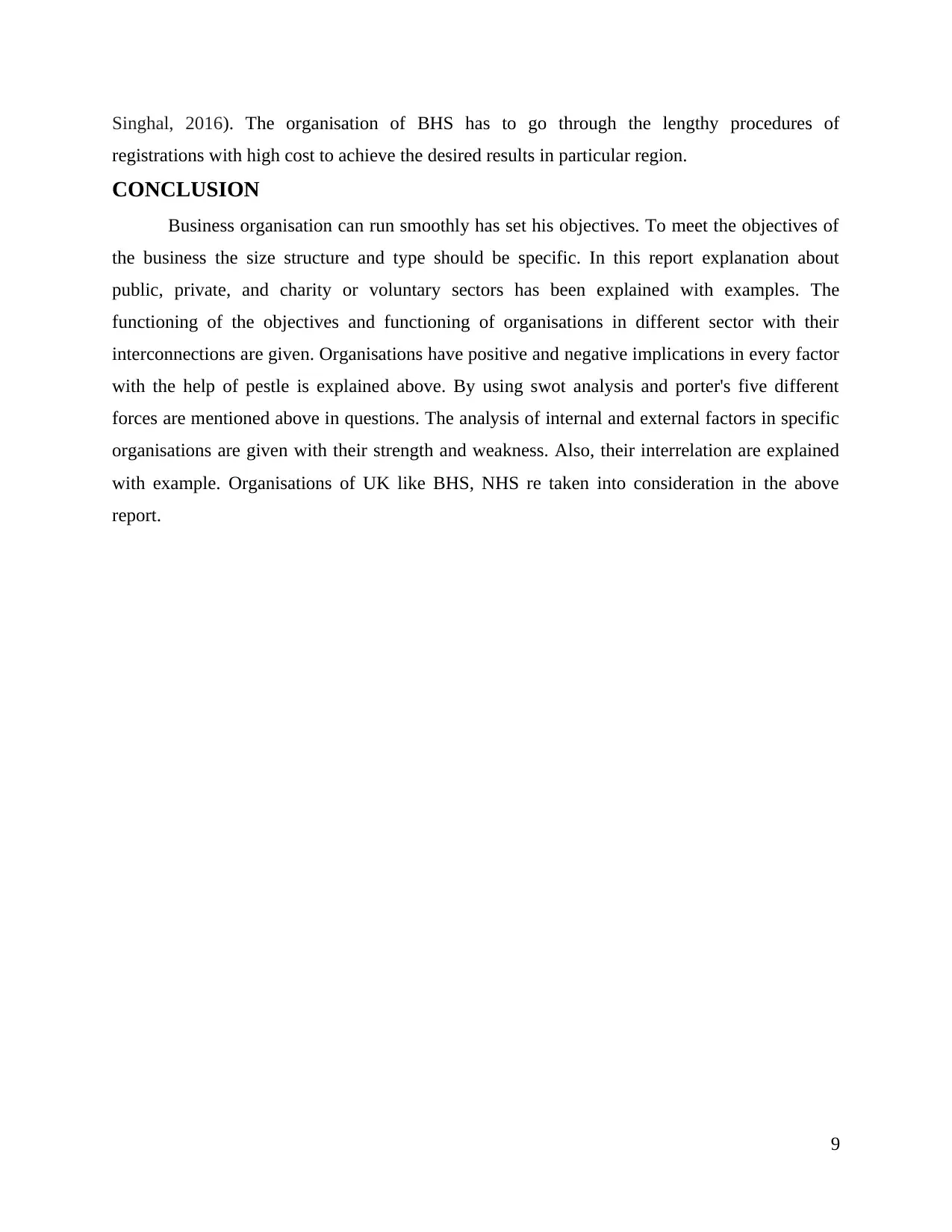
Singhal, 2016). The organisation of BHS has to go through the lengthy procedures of
registrations with high cost to achieve the desired results in particular region.
CONCLUSION
Business organisation can run smoothly has set his objectives. To meet the objectives of
the business the size structure and type should be specific. In this report explanation about
public, private, and charity or voluntary sectors has been explained with examples. The
functioning of the objectives and functioning of organisations in different sector with their
interconnections are given. Organisations have positive and negative implications in every factor
with the help of pestle is explained above. By using swot analysis and porter's five different
forces are mentioned above in questions. The analysis of internal and external factors in specific
organisations are given with their strength and weakness. Also, their interrelation are explained
with example. Organisations of UK like BHS, NHS re taken into consideration in the above
report.
9
registrations with high cost to achieve the desired results in particular region.
CONCLUSION
Business organisation can run smoothly has set his objectives. To meet the objectives of
the business the size structure and type should be specific. In this report explanation about
public, private, and charity or voluntary sectors has been explained with examples. The
functioning of the objectives and functioning of organisations in different sector with their
interconnections are given. Organisations have positive and negative implications in every factor
with the help of pestle is explained above. By using swot analysis and porter's five different
forces are mentioned above in questions. The analysis of internal and external factors in specific
organisations are given with their strength and weakness. Also, their interrelation are explained
with example. Organisations of UK like BHS, NHS re taken into consideration in the above
report.
9
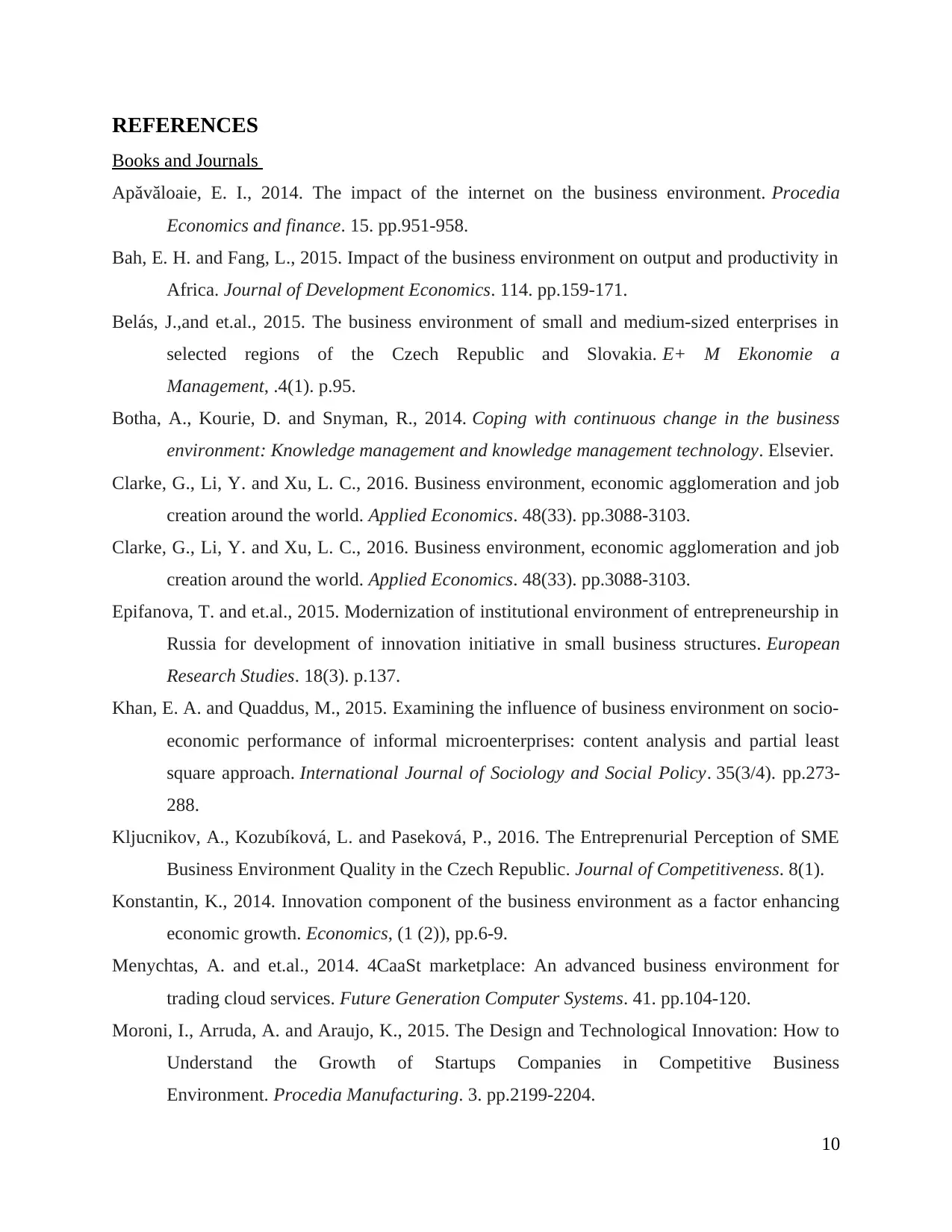
REFERENCES
Books and Journals
Apăvăloaie, E. I., 2014. The impact of the internet on the business environment. Procedia
Economics and finance. 15. pp.951-958.
Bah, E. H. and Fang, L., 2015. Impact of the business environment on output and productivity in
Africa. Journal of Development Economics. 114. pp.159-171.
Belás, J.,and et.al., 2015. The business environment of small and medium-sized enterprises in
selected regions of the Czech Republic and Slovakia. E+ M Ekonomie a
Management, .4(1). p.95.
Botha, A., Kourie, D. and Snyman, R., 2014. Coping with continuous change in the business
environment: Knowledge management and knowledge management technology. Elsevier.
Clarke, G., Li, Y. and Xu, L. C., 2016. Business environment, economic agglomeration and job
creation around the world. Applied Economics. 48(33). pp.3088-3103.
Clarke, G., Li, Y. and Xu, L. C., 2016. Business environment, economic agglomeration and job
creation around the world. Applied Economics. 48(33). pp.3088-3103.
Epifanova, T. and et.al., 2015. Modernization of institutional environment of entrepreneurship in
Russia for development of innovation initiative in small business structures. European
Research Studies. 18(3). p.137.
Khan, E. A. and Quaddus, M., 2015. Examining the influence of business environment on socio-
economic performance of informal microenterprises: content analysis and partial least
square approach. International Journal of Sociology and Social Policy. 35(3/4). pp.273-
288.
Kljucnikov, A., Kozubíková, L. and Paseková, P., 2016. The Entreprenurial Perception of SME
Business Environment Quality in the Czech Republic. Journal of Competitiveness. 8(1).
Konstantin, K., 2014. Innovation component of the business environment as a factor enhancing
economic growth. Economics, (1 (2)), pp.6-9.
Menychtas, A. and et.al., 2014. 4CaaSt marketplace: An advanced business environment for
trading cloud services. Future Generation Computer Systems. 41. pp.104-120.
Moroni, I., Arruda, A. and Araujo, K., 2015. The Design and Technological Innovation: How to
Understand the Growth of Startups Companies in Competitive Business
Environment. Procedia Manufacturing. 3. pp.2199-2204.
10
Books and Journals
Apăvăloaie, E. I., 2014. The impact of the internet on the business environment. Procedia
Economics and finance. 15. pp.951-958.
Bah, E. H. and Fang, L., 2015. Impact of the business environment on output and productivity in
Africa. Journal of Development Economics. 114. pp.159-171.
Belás, J.,and et.al., 2015. The business environment of small and medium-sized enterprises in
selected regions of the Czech Republic and Slovakia. E+ M Ekonomie a
Management, .4(1). p.95.
Botha, A., Kourie, D. and Snyman, R., 2014. Coping with continuous change in the business
environment: Knowledge management and knowledge management technology. Elsevier.
Clarke, G., Li, Y. and Xu, L. C., 2016. Business environment, economic agglomeration and job
creation around the world. Applied Economics. 48(33). pp.3088-3103.
Clarke, G., Li, Y. and Xu, L. C., 2016. Business environment, economic agglomeration and job
creation around the world. Applied Economics. 48(33). pp.3088-3103.
Epifanova, T. and et.al., 2015. Modernization of institutional environment of entrepreneurship in
Russia for development of innovation initiative in small business structures. European
Research Studies. 18(3). p.137.
Khan, E. A. and Quaddus, M., 2015. Examining the influence of business environment on socio-
economic performance of informal microenterprises: content analysis and partial least
square approach. International Journal of Sociology and Social Policy. 35(3/4). pp.273-
288.
Kljucnikov, A., Kozubíková, L. and Paseková, P., 2016. The Entreprenurial Perception of SME
Business Environment Quality in the Czech Republic. Journal of Competitiveness. 8(1).
Konstantin, K., 2014. Innovation component of the business environment as a factor enhancing
economic growth. Economics, (1 (2)), pp.6-9.
Menychtas, A. and et.al., 2014. 4CaaSt marketplace: An advanced business environment for
trading cloud services. Future Generation Computer Systems. 41. pp.104-120.
Moroni, I., Arruda, A. and Araujo, K., 2015. The Design and Technological Innovation: How to
Understand the Growth of Startups Companies in Competitive Business
Environment. Procedia Manufacturing. 3. pp.2199-2204.
10
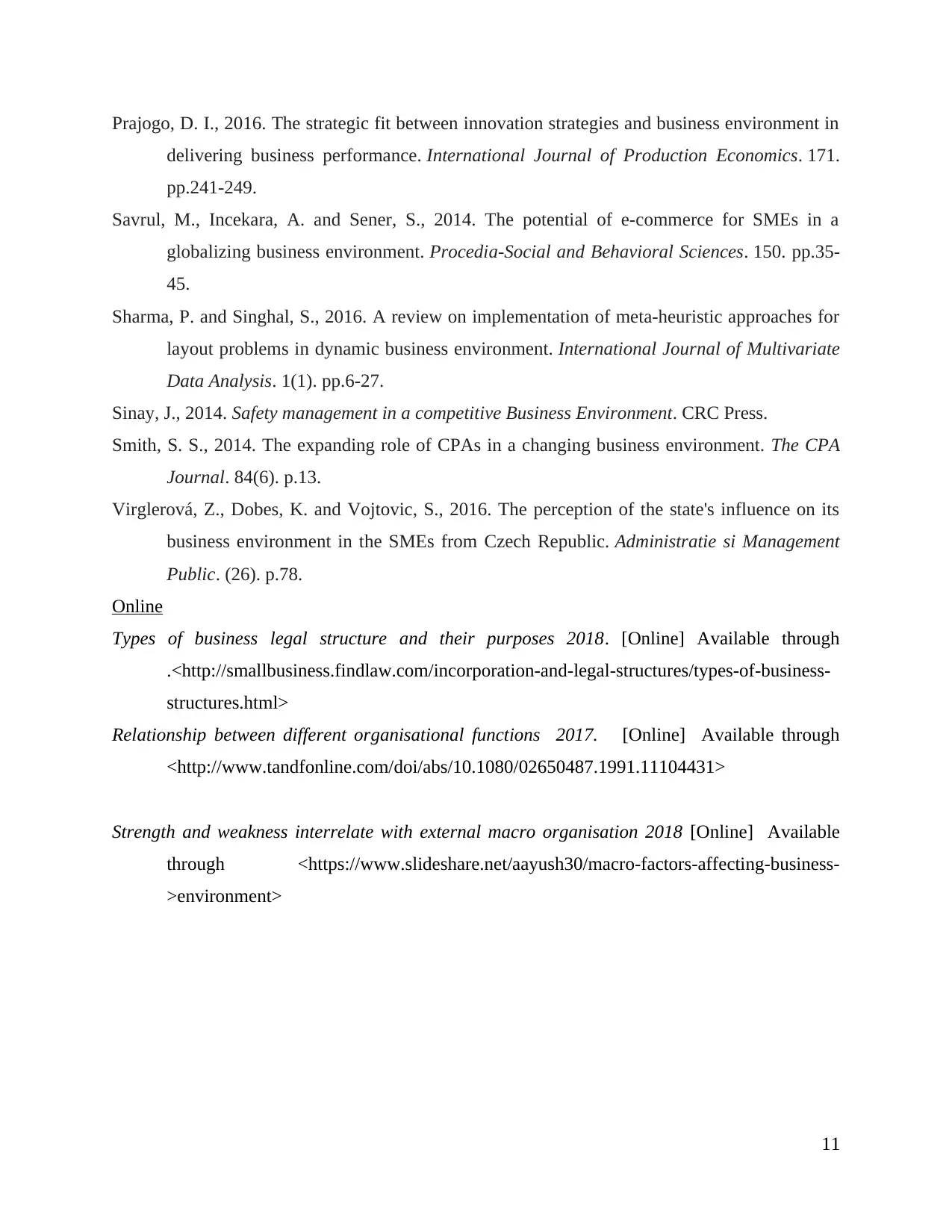
Prajogo, D. I., 2016. The strategic fit between innovation strategies and business environment in
delivering business performance. International Journal of Production Economics. 171.
pp.241-249.
Savrul, M., Incekara, A. and Sener, S., 2014. The potential of e-commerce for SMEs in a
globalizing business environment. Procedia-Social and Behavioral Sciences. 150. pp.35-
45.
Sharma, P. and Singhal, S., 2016. A review on implementation of meta-heuristic approaches for
layout problems in dynamic business environment. International Journal of Multivariate
Data Analysis. 1(1). pp.6-27.
Sinay, J., 2014. Safety management in a competitive Business Environment. CRC Press.
Smith, S. S., 2014. The expanding role of CPAs in a changing business environment. The CPA
Journal. 84(6). p.13.
Virglerová, Z., Dobes, K. and Vojtovic, S., 2016. The perception of the state's influence on its
business environment in the SMEs from Czech Republic. Administratie si Management
Public. (26). p.78.
Online
Types of business legal structure and their purposes 2018. [Online] Available through
.<http://smallbusiness.findlaw.com/incorporation-and-legal-structures/types-of-business-
structures.html>
Relationship between different organisational functions 2017. [Online] Available through
<http://www.tandfonline.com/doi/abs/10.1080/02650487.1991.11104431>
Strength and weakness interrelate with external macro organisation 2018 [Online] Available
through <https://www.slideshare.net/aayush30/macro-factors-affecting-business-
>environment>
11
delivering business performance. International Journal of Production Economics. 171.
pp.241-249.
Savrul, M., Incekara, A. and Sener, S., 2014. The potential of e-commerce for SMEs in a
globalizing business environment. Procedia-Social and Behavioral Sciences. 150. pp.35-
45.
Sharma, P. and Singhal, S., 2016. A review on implementation of meta-heuristic approaches for
layout problems in dynamic business environment. International Journal of Multivariate
Data Analysis. 1(1). pp.6-27.
Sinay, J., 2014. Safety management in a competitive Business Environment. CRC Press.
Smith, S. S., 2014. The expanding role of CPAs in a changing business environment. The CPA
Journal. 84(6). p.13.
Virglerová, Z., Dobes, K. and Vojtovic, S., 2016. The perception of the state's influence on its
business environment in the SMEs from Czech Republic. Administratie si Management
Public. (26). p.78.
Online
Types of business legal structure and their purposes 2018. [Online] Available through
.<http://smallbusiness.findlaw.com/incorporation-and-legal-structures/types-of-business-
structures.html>
Relationship between different organisational functions 2017. [Online] Available through
<http://www.tandfonline.com/doi/abs/10.1080/02650487.1991.11104431>
Strength and weakness interrelate with external macro organisation 2018 [Online] Available
through <https://www.slideshare.net/aayush30/macro-factors-affecting-business-
>environment>
11
1 out of 13
Related Documents
Your All-in-One AI-Powered Toolkit for Academic Success.
+13062052269
info@desklib.com
Available 24*7 on WhatsApp / Email
![[object Object]](/_next/static/media/star-bottom.7253800d.svg)
Unlock your academic potential
© 2024 | Zucol Services PVT LTD | All rights reserved.





